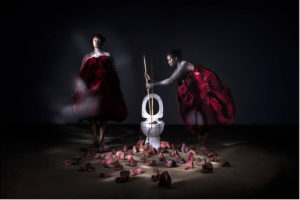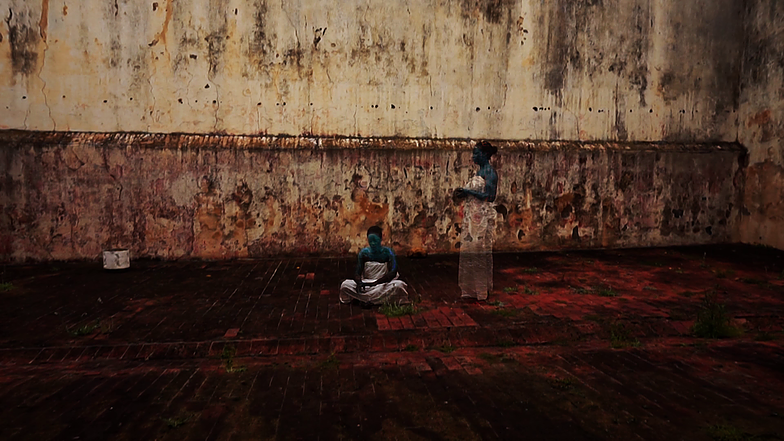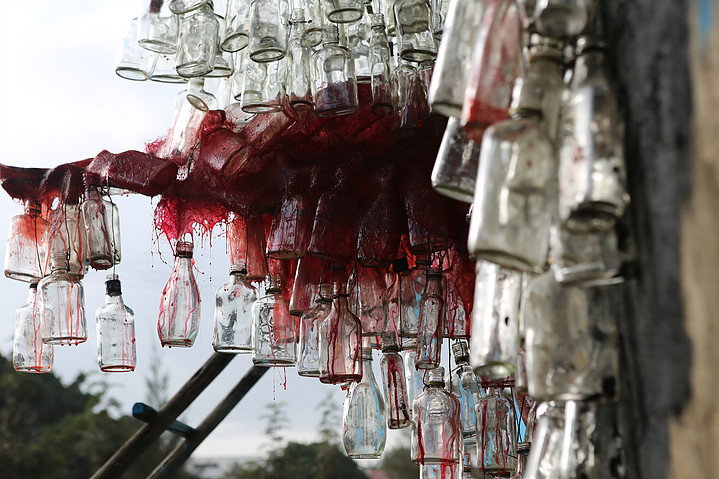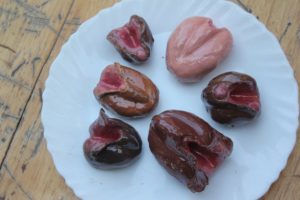
Research is pivotal in my opinion to creating a strong body of work and also to have different viewpoints of a specific topic of interest. It must however be of significance to the researcher or artist. How it is perceived and of what relevance it holds to anyone besides the artist is relative. My concepts are more or less birthed from a personal context and then blown out of proportion, shrunk, distorted or disintegrated from which possible meaning and interpretations are shifted.
Matt Kayem, Ugandan artist and art critic, interviews Stacey Gillian Abe
Enya Sa I, 2017
Stacey Gillian Abe
An Exchange
Stacey is one of the younger generation of Ugandan artists rippling the international art scene. A graduate of Kyambogo University in 2014, she is steadily making her presence felt in the industry with her work that highlights the strength and fragility of the female mind. She adds this to her fascination with merging the human experience and the spiritual realm, believing these spheres influence and form our individual identities. Her practice stretches from photography to sculpture, installation, performance and painting.
*
On top of exhibiting her work in several shows around East Africa, Stacey was awarded the 2017 Project Space residency in Johannesburg. Last month, she was listed on Africa’s Forbes under 30 with fellow young creatives like Wiz kid, Tony Gum, Eddy Kamuanga and many others.
*
I’m interested in the intellectual prowess and maturity in Stacey’s work which you wouldn’t normally expect from a young person like her. Her work evokes a feeling that it has been well-thought out, planned and thoroughly researched. The visual quality in her work is proof that she possesses that much-needed eye in this field. She incorporates a metaphorical and experimental approach to her work through her interest in exploring new techniques with parallel mediums like glass and ceramics, fibers, textures and light photography. Through tying together, binding, stitching and clustering, allegorical layers come together in her work. With all this attached to a young lady like her, it created reason to hunt her down for a good old interview.
*
Her busy travelling schedule did not permit a physical interview but thanks technology, we exchanged texts on email about spirituality, art success, religion and the black female body. She maintains that she’s reserved but not an introvert so it was my job to open her up. Let’s find out if I did a good job.

Self Portrait of Stacey Gillian Abe.
MK: First of all, I want to thank and congratulate you on the various milestones you’ve hit lately in your career. As an emerging artist and one following behind you, I feel the path has been created and it is possible to scale the heights.
SGA : I’m humbled, I try.
MK: As a young child growing up, did you ever see yourself becoming an artist?
SGA: Yes very much so. I loved everything arty and crafty, most of it was driven by the need to create something and curiosity.
MK: Are your parents and family supportive of your career choice?
SGA: My family is supportive of what I do. I can’t say they understand it entirely but that’s fair enough.

Indigogo, a shot from a video still.
MK: Who are the artists, past and present, African and global that have shaped your thinking or inspired you and why?
SGA: I can’t say I have specific artists I look up to, but I enjoy indulging in a very long list of artists for diverse reasons and it keeps changing. I like discovering and rediscovering art and artists far from my practice and keeping an open mind.
MK: I have seen your installations, drawings and now of recent, photographs of your work. Do you think you are an all-round or multidisciplinary artist? What is your most comfortable area of expression?
SGA: I think a little bit of both? I have a background in sculpture, installation and painting but very interested in trying out new media and seeing how these materialize in my work is very exciting.
MK: When I saw your installation Unknown at the Kampala Biennale 2016, I couldn’t get myself to understand what was going on because I hadn’t yet matured intellectually and art wise. Reading about it now in articles online, I’m struck and can now relate to the intellectual depth in the work. How do you arrive at such work? Do you read and research extensively?
SGA: Research is pivotal in my opinion to creating a strong body of work and also to have different viewpoints of a specific topic of interest. It must however be of significance to the researcher or artist. How it is perceived and of what relevance it holds to anyone besides the artist is relative. My concepts are more or less birthed from a personal context and then blown out of proportion, shrunk, distorted or disintegrated from which possible meaning and interpretations are shifted.

Unknown, video installation exhibited at the 2016 Kampala Biennale. Source: iam-africa.com
MK: I don’t hear so many young people in Uganda talk about spirituality yet it’s one of the themes you deal with in your work. Tell me about your journey to spirituality, how did you end up in this path?
SGA: Spirituality to me refers to subjective experiences of a sacred dimension and the deep values and meanings by which people live far from organized religion, personal growth, a quest for an ultimate meaning, or an encounter with one’s own inner dimension. I personally believe we are spiritual beings and that there exists no hard and fast distinction between the spiritual and physical (or material) world and a life oriented towards an inner being. I fancy the thought of being in constant merge this ‘other’ dimension.
MK: Do you subscribe to any religious affiliation?
SGA: Yes, I am Christian.
MK: Some of your work deals with gender misconceptions, strength and vulnerability of the female. And now on the continent that there is a wave of Afrocentrism and an urge to decolonize which means recognizing and appreciating our traditional culture. Do you find yourself having a struggle to find a balance between western modernism and your Africanity or you have already thrown away one of them?
SGA: There is always a struggle, but not one I am failing to handle and much of that is materialized in my work

Sticky Situation, detail installation
MK: Your work, Enyasa which explores sexual satisfaction in relation to food, the female body and objectification, is a bold display of free-spiritedness and nonconformist with the presentation of vaginal sculptures. Do you think it is important for an artist to free their mind and not fall prey to the expectations and demands of their society to express themselves well?
SGA: I think every artist has their own unique way of expression and how we express ourselves individually as artists is what makes us all different. I also feel it is important for an artist to be true to themselves and their voices irrespective of various external factors. There is no right way of voicing out something, how it’s done it is totally up to the artist as long as they are able to sleep soundly at night and feel comfortable in their own skin. Expression comes in so many forms, one could express themselves towards a situation in positivity of against a constraint in negativity or simply leave it open ended and up for debate, or not say anything at all. How it’s done isn’t the point, but of what value it is could be. It’s all so comparative. There is need for a certain level of urgency and assertion though.

Enyasa, Stacey’s controversial sculpture work with painted terracotta. Source: thisisafrica.me
MK: You were just awarded the Project Space residency in South Africa. How was the experience and how do you compare the Kampala art scene with the one in Johannesburg?
SGA: It was a great learning experience for the most part. Johannesburg’s art scene is fast, wide and very active .The Kampala art scene is fast growing and vibrant, a community that has weathered decades of the country’s unfavorable political condition to the creative sector and yet still thrives to be internationally rediscovered in a new light. I am not an expert analyst so I will not make assumptions
MK: What do you attribute this journey, your success to? What should young ladies, mostly in Uganda trying to be artists do or emulate?
SGA: For the most part being true to one self and strong willed plus having an open mind and patience is something to consider.
This video was posted in 2017
MK: What is your definition of a successful artist and at what point in your career would you readily accept the word ‘success’ attached to your name?
SGA: What is success? Success is relative and measured in many ways. I do not know if I would ever wake up and be comfortable with that word. It is all so egoist in my ears. I do not understand what that word means. However, if you had asked about growth? I can say I am growing intellectually/mentally, spiritually and artistically to mention but a few, am not yet there but looking up to ultimate growth.
